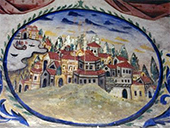Boris Khaimovich
Catalogue of Wall Paintings in Central and East European Synagogues
edited by Vladimir Levin
The Catalogue represents one of the modules comprising the Bezalel Narkiss Index of Jewish Art. It includes murals created within the framework of traditional Jewish folk culture (while omitting decorative paintings belonging to historicist building design). Read more...
Boris Khaimovich
Catalogue of Wall Paintings in Central and East European Synagogues
edited by Vladimir Levin
The Catalogue represents one of the modules comprising the Bezalel Narkiss Index of Jewish Art. It includes murals created within the framework of traditional Jewish folk culture (while omitting decorative paintings belonging to historicist building design).
The Center for Jewish Art intends the Catalogue to include records of all known murals from both extant and non-extant synagogues. In the latter case, surviving photographs and verbal descriptions bear witness to the destroyed works of art. The records of all paintings furnish information about creators, dates, iconographical subjects, and inscriptions.
Synagogue murals constitute a historical and cultural phenomenon that first spread through Central and Eastern Europe in the late sixteenth and early seventeenth centuries. This early development reached its high point in the seventeenth and eighteenth centuries with artwork painted on the walls and ceilings of wooden synagogues. The murals of this period are characterized by original artistic language, an established composition program, and a variety of symbolic and decorative motifs. In the late nineteenth century European art genres exerted a definite influence on the decoration programs of synagogues. Subsequently, the first half of the twentieth century saw a new peak in the popularity of synagogue paintings. Even after the Holocaust some surviving communities continued this tradition and tried to observe the traditional “canon” in the decoration of their synagogues. Notwithstanding the manifest influence of European art, the synagogue murals have no counterpart in the sacred buildings of the surrounding Christian culture.
The Catalogue is based primarily on materials collected by the Center for Jewish Art during expeditions undertaken from 1994 to 2015, as well as archival photographs from several collections in Europe and Israel.
We believe that the Catalogue will provide a new basis for scholarly study of the iconography and symbolism of Jewish folk art, serve as a convenient starting point for restorers of extant synagogues, and help expose the broader public to the richness and diversity of Jewish symbolism and the Jewish heritage as a whole.
Dr. Boris Khaimovich
Dr. Vladimir Levin
Jerusalem, February 2017
We thank the following participants of the project:
Dipl.-Ing. Zoya Arshavsky, architectural drafter
Alla Kucherenko, Hebrew inscriptions editor
Karina Kordiukova, research assistant
Dr. Yeshayahu Gruber, language editor
Carmen Echevarria, language editor
Mark Gondelman, Programmer
Gilad Hemed, Digitization, Web Master, Graphic Designer and Administration Director
















